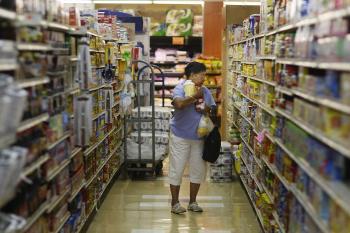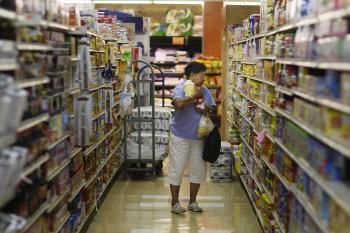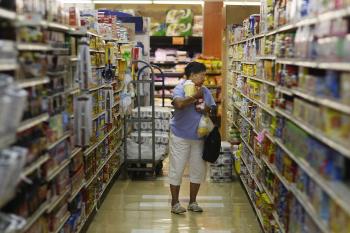NEW YORK—Consumers are being warned off of some melamine-tainted products from China, but it’s the products they don’t know about that could hurt them. The problem lies in the testing and identification system for imported ingredients, say experts.
“Any product that comes from China, if it’s prepackaged, they’ve had to be labeled since 1930, so that country of origin should be on there,” says Dr. Michael Hansen, Senior Scientist for Food Safety at Consumers Union. The nonprofit publishes Consumer Reports magazine. Hansen says that danger lies in the rules related to labeling after ingredients are imported.
“If somebody buys an ingredient from China and mixes it with stuff here…they don’t necessarily have to label it [with a country of origin],” says Hansen. “A lot of things that they’re concerned with, with these melamine products, they’re all going to be exempt. Milk powder that is added to pastry products, or anything like that, that’s processed—that’s all going to be exempt.”
The Federal Drug Administration (FDA) has been screening and testing some products from China, but by its own reckoning there are gaps in scientific knowledge needed to assess the toxicity of melamine.
According to a statement released by the FDA on Oct. 3, they cannot establish “any level of melamine and melamine-related compounds in infant formula that does not raise public health concerns. In large part, this is because of gaps in our scientific knowledge about the toxicity of melamine and its analogues in infants.”
According to the World Health Organization (WHO), over 54,000 infants and young children in China have sought treatment for urinary problems, possible renal tube blockages, and possible kidney stones related to the melamine contamination of infant formula and related dairy products. Over 14,000 infants have been hospitalized and just over 1,000 have been released from care.
WHO says that kidney stones in infants are very rare.
Melamine Uses and Health Impacts
China’s melamine problem stems from the unsanctioned practice of adding water to raw milk to increase its volume. The resulting lowered protein concentration leads to companies using the milk for further production in food products (such as infant formula) to add melamine to increase the nitrogen content of the milk. The process creates the illusion of a certain level of protein. The addition of melamine in food has not been approved for consumption by authorities in any nation.
Melamine’s intended use is as a binding agent, typically in plastics, adhesives, countertops, dishware, and whiteboards. In 2007, it was found in wheat gluten and rice protein concentrate exported from China. The ingredients were used to manufacture pet food in the U.S. and caused a large number of cats and dogs to die of kidney failure.
In the U.S., melamine could potentially be found in numerous products that are marked as made in the U.S., as well as imported from China.
Energy Bars and Drinks
“Milk protein concentrate can come from anywhere, some of it would be coming from China,” says Hansen of Consumers Union, who says that items like energy drinks and bars have some of the highest levels of milk protein concentrate outside of products from China—and consumers should be aware. “People who would be training for triathalons will buy these protein powders in dietary supplement stores, those could contain it. Some of the nutrition bars also would use milk protein as a binding agent.”
“Anything, if it looks like it might have come from China—be concerned,” says Hansen. “And since it’s all about cheapness, it’s going to be in the cheaper products. But until there’s a lot of testing, we just don’t know. We do know that things like protein concentrate are found in a wide range of items, and they all need to be tested.”
Although no known cases of human melamine poisoning have been reported in the U.S., the symptoms are generic enough that it could be difficult to track. According to WHO, symptoms include irritability, blood in urine, little or no urine, signs of kidney infection, and high blood pressure.
In its Oct. 3 statement, the FDA said that levels of melamine and melamine-related compounds below 2.5 parts per million (ppm) “do not raise concerns.” The calculation is based on a worse case scenario of exposure in which 50 percent of the diet is contaminated.
Contamination Cases Worldwide
The number of “Made in China” food products contaminated with melamine continues to increase around the world. In Hong Kong, Cadbury chocolates and other products were tested and found to have melamine. Cadbury, one of the world’s largest chocolate makers, announced a recall of eleven of its products late last month of milk-based chocolates being sold in Hong Kong, Taiwan, and Australia.
On Oct. 8, The Canadian Food Inspection Agency (CFIA) warned the public not to consume, distribute, or sell Sherwood Brands Pirate’s Gold Milk Chocolate Coins. The coins are sold and distributed in the U.S. and Canada. Sherwood Brands offices in both countries could not be reached for comment.
Media reports have named at least 41 countries that have imposed restrictions on Chinese products containing dairy items. At least 25 of these 41 countries have imposed blanket bans on Chinese milk products or its derivatives.
Follow the White Rabbit
Some consumer confusion over what products to be wary of could be rooted in conflicting and rapidly changing information. White Rabbit Creamy Candies is a stark example.
On Sept. 26 the FDA issued a press release that Queensway Food Company, Inc. of Burlingame, California was recalling White Rabbit Brand Creamy Candies for possible melamine contamination. One of the nine states the candy was recalled from included New York.
However, according to a list provided via email to The Epoch Times on Oct. 7 by Jessica A. Chittenden, Communications Director with the New York State Department of Agriculture and Markets, the product is now not a risk factor. Chittenden’s email said that several items in New York “have been received and tested…all tested negative for melamine.” The items include White Rabbit Brand Creamy Candies.
On the other hand, the Connecticut Department of Consumer Affairs has found and destroyed hundreds of bags of the candy.
“I wouldn’t say that the FDA has done enough testing that we can all rest easy,” says Jean Halloran, Director of Food Policy Initiatives for Consumers Union.
“People should be especially concerned about what they are buying in Asian markets, because that’s most likely to have ingredients from China,” adds Halloran. “The candy, the Mr. Brown products obviously should be avoided. I would say that any item that contains milk ingredients that is made in China, it would be prudent to avoid them.”
Halloran adds that any infant formula that’s made in China should be avoided, but stopping there might not be enough of a precaution.
“There will be some products where consumers are not necessarily aware that there is a milk ingredient that would have come in bulk from China and would have been included in a product that was manufactured here,” says Halloran.
“At this point, we’re really reliant on FDA testing. And we don’t know how much they’ve tested. They told us today that they’ve done a few hundred products. That’s a very small number, relative to what may be out there.”






